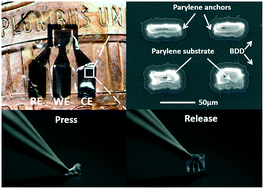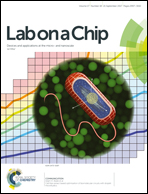Large-scale, all polycrystalline diamond structures transferred onto flexible Parylene-C films for neurotransmitter sensing
Abstract
Boron-doped diamond (BDD) has superior electrochemical properties for bioelectronic systems. However, due to its high synthesis temperature, traditional microfabrication methods have limits to integrating BDD with emerging classes of flexible, polymer-based bioelectronic systems. This paper introduces a novel fabrication solution to this challenge, which features (i) a wafer-scale substrate transfer process with all diamond structures transferred onto a flexible Parylene-C substrate and (ii) Parylene anchors introduced to strengthen the bonding between BDD and Parylene substrates, as demonstrated by a peeling test. The electrochemical properties of the transferred BDD–polymer electrodes are evaluated using (i) an outer sphere redox couple Ru(NH3)62+/3+ to study the electron transfer process and (ii) quantitative and qualitative studies of the neurotransmitter redox couple dopamine/dopamine-o-quinone. A linear response of the BDD sensor to dopamine concentrations of 0.5 μM to 100 μM is observed (R2 = 0.999) with a sensitivity of 0.21 μA cm−2 μM−1. These examples of fabricated diamond–polymer devices suggest a broad application in advanced bioelectronics and optoelectronics.



 Please wait while we load your content...
Please wait while we load your content...